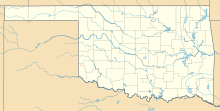| Antelope Hills expedition | |||||||
|---|---|---|---|---|---|---|---|
| Part of the American Indian Wars, Texas-Indian Wars, Apache Wars | |||||||
 Comanches of West Texas in war regalia. Painting by Lino Sánchez y Tapia, circa 1830s | |||||||
| |||||||
| Belligerents | |||||||
|
Tonkawa Anadarko Shawnee |
Comanche Kiowa Apache | ||||||
| Commanders and leaders | |||||||
|
Placido |
Iron Jacket † Peta Nocona | ||||||
| Strength | |||||||
| ~220 | 200–600 | ||||||
| Casualties and losses | |||||||
| ~50 killed or wounded |
76 killed 16 captured | ||||||
Location within Oklahoma | |||||||

The Antelope Hills expedition was a campaign from January to May 1858 by the Texas Rangers and members of other allied Native American tribes against Comanche and Kiowa villages in the Comancheria. It began in western Texas and ended in a series of fights with the Comanche tribe on May 12, 1858, at a place called Antelope Hills by Little Robe Creek, a tributary of the Canadian River in what is now Oklahoma. The hills are also called the "South Canadians", as they surround the Canadian River. The fighting on May 12, 1858, is often called the Battle of Little Robe Creek.

